Electroelastic Coupled-Wave Scattering and Dynamic Stress Concentration of Triangular Defect Piezoceramics
Abstract
:1. Introduction
2. The Basic Equations of Two-Dimensional Anti-plane Problems in Cylindrical Coordinates
3. Solutions of Incident, Scattered, and Total Electroelastic Waves in Piezoelectric Materials with Triangular Defects
4. Boundary Conditions and Determination of Mode Coefficients
5. Dynamic Stress Concentration Factor
6. Numerical Examples Simulation and Discussion
7. Conclusions
- Supported by the currently available data, Ce doping and elevated temperature (between 1350–1500 °C) will increase the piezoelectric constant of the (Ba0.85Ca0.15)(Zr0.1Ti0.9)O3.
- As ka increases, the stress concentration around the defect fluctuates more violently, and the increase of the piezoelectric coefficient will make the stress concentration more serious. In addition, the stress concentration of the triangular defects is obvious at the three vertices.
- When ka changes from 0 to 5, the stress concentration trend around the defect is similar to that of ka = 0.1 and ka = 0.5. The only thing that changes greatly is the maximum value of stress concentration (stress concentration coefficients on the three vertices). With the increase of ka, the maximum value of the stress concentration factor has a general trend of first increasing and then decreasing. The stress concentration factor peaks in the range of ka = 4~5.
- Under different deflection angles, the stress concentration phenomenon is still concentrated at the vertex of the triangle. However, as the deflection angle increases, the magnitude of the stress concentration factor becomes smaller.
- The maximum value of the stress concentration factor decreases as the absolute value of the deflection angle increases. The variation trend of the maximum stress concentration factor with can be considered to be almost symmetric at about x = 0 and take a maximum value at x = 0.
- The difference in temperature and the amount of Ce doping is essentially the difference in piezoelectric constant. Within the data range of this study, the better the piezoelectric performance, the more intense the piezoelectric effect and the greater the magnitude of the stress concentration factor.
Author Contributions
Funding
Institutional Review Board Statement
Informed Consent Statement
Data Availability Statement
Conflicts of Interest
References
- Jaffe, B.; Cook, W.R.; Jaffe, H. Piezoelectric Ceramic; Academic Press: Cambridge, MA, USA, 1971. [Google Scholar]
- Juergen, R.; Li, J.F. Lead-free piezoceramics: Status and perspectives. MRS Bull. 2018, 43, 576–580. [Google Scholar] [CrossRef] [Green Version]
- Takenaka, T.; Okuda, T.; Takegahara, K. Lead-free piezoelectric ceramics based on (Bi1/2Na1/2)TiO3-NaNbO3. Ferroelectrics 1997, 196, 175–178. [Google Scholar] [CrossRef]
- Takenaka, T. Piezoelectric properties of some lead-free ferroelectric ceramics. Ferroelectrics 1999, 230, 87–98. [Google Scholar] [CrossRef]
- Nagata, H.; Takenaka, T. Additive effects on electrical properties of (Bi1/2 Na1/2)TiO3 ferroelectric ceramics. J. Eur. Ceram. Soc. 2001, 21, 1299–1302. [Google Scholar] [CrossRef]
- Saito, Y.; Takao, H.; Tani, T. Lead-free piezoceramics. Nature 2004, 432, 84–87. [Google Scholar] [CrossRef] [PubMed]
- Takenaka, T.; Nagata, H. Current status and prospects of lead-free piezoelectric ceramics. J. Eur. Ceram. Soc. 2005, 25, 2693–2700. [Google Scholar] [CrossRef]
- Berlincourt, D.A. Piezoelectric and piezomagnetic materials and their function in transducers. Phys. Acoust. 1964, 1, 169–270. [Google Scholar] [CrossRef]
- Wu, Y.H.; Ma, F.; Qu, J.K. Enhanced mechanical and piezoelectric properties of BCZT-CuY/rGO-based nanogenerator for tiny energy harvesting. Mater. Lett. 2018, 231, 20–23. [Google Scholar] [CrossRef]
- Sun, M.; Li, P.; Hu, C.; Du, J.; Li, W. Polarization-induced phase structure transition and change of photoluminescence in Er 3+ -doped (Ba, Ca)(Ti, Sn)O 3 -based multifunctional ceramics. J. Mater. Sci. 2021, 56, 10204–10217. [Google Scholar] [CrossRef]
- Wu, K.; Wang, H.; Zhou, X. Large energy storage density and efficiency of Sm2O3 -doped Ba 0.85 Ca 0.15 Zr 0.08 Ti 0.92 O 3 lead-free ceramics. J. Mater. Sci. 2021, 32, 1–11. [Google Scholar] [CrossRef]
- Chandraiah, M.; Panda, P.K. Effect of dopants (A=Mg2+, Ca2+ and Sr2+) on ferroelectric, dielectric and piezoelectric properties of (Ba1xAx) (Ti0.98Zr0.02) O3 lead-free piezo ceramics. Ceram. Int. 2015, 41, 8040–8045. [Google Scholar] [CrossRef]
- Koruza, J.; Bell, A.J.; Frmling, T. Requirements for the Transfer of Lead-free Piezoceramics into Application. J. Mater. 2018, 4, 13–26. [Google Scholar] [CrossRef]
- Parton, V.Z. Fracture mechanics of piezoelectric materials. Acta Astronaut. 1976, 3, 671–683. [Google Scholar] [CrossRef]
- Sosa, H. Plane problems in piezoelectric media with defects. Int. J. Solids Struct. 1991, 28, 491–505. [Google Scholar] [CrossRef]
- Liu, W.; Ren, X. Large Piezoelectric Effect in Pb-Free Ceramics. Phys. Rev. Lett. 2009, 103, 257602. [Google Scholar] [CrossRef] [Green Version]
- Barnett, D.M.; Asaro, R.J. The fracture mechanics of slit-like cracks in anisotropic elastic media. J. Mech. Phys. Solids 1972, 20, 353–366. [Google Scholar] [CrossRef]
- Xu, X.L.; Rajapakse, R. On a plane crack in piezoelectric solids. Int. J. Solids Struct. 2001, 38, 7643–7658. [Google Scholar] [CrossRef]
- Mcmeeking, R.M. The energy release rate for a Griffith crack in a piezoelectric material. Eng. Fract. Mech. 2004, 71, 1149–1163. [Google Scholar] [CrossRef]
- Pak, Y.E. Linear electro-elastic fracture mechanics of piezoelectric materials. J. Appl. Mech. 1992, 112, 79–100. [Google Scholar] [CrossRef]
- Wang, X.; Yong, Z.; Zhou, W. A novel hybrid finite element with a hole for analysis of plane piezoelectric medium with defects. Int. J. Solids Struct. 2004, 41, 7111–7128. [Google Scholar] [CrossRef]
- Liang, Y.C.; Sun, Y.P.; Wu, L.N. Hole problems in a circular piezoelectric plate. T Can. Soc. Mech. Eng. 2016, 40, 491–500. [Google Scholar] [CrossRef]
- Kaloerov, S.A.; Glushchenko, Y.A. Electroelastic State of a Multiply Connected Piezoelectric Half Plane with Holes and Cracks. J. Math. Sci. 2001, 107, 4416–4424. [Google Scholar] [CrossRef]
- Xiao, J.H.; Xu, Y.L.; Zhang, F.C. Fracture characteristics of a cracked equilateral triangle hole with surface effect in piezoelectric materials. Theor. Appl. Fract. Mec. 2018, 96, 476–482. [Google Scholar] [CrossRef]
- Xiao, J.; Xu, Y.; Zhang, F. Fracture Characteristics of Cracked Hole in Piezoelectric Solids Considering Surface Effect. Acta Mech. Solida Sinica 2019, 40, 269–276. [Google Scholar] [CrossRef]
- Xiao, J.; Xu, B.X.; Xu, Y. Fracture analysis on a cracked elliptical hole with surface effect in magnetoelectroelastic solid. Theor. Appl. Fract. Mec. 2020, 107, 102532. [Google Scholar] [CrossRef]
- Dai, M.; Schiavone, P. An anisotropic piezoelectric half-plane containing an elliptical hole or crack subjected to uniform in-plane electromechanical loading. J. Mech. Mater. Struct. 2016, 11, 433–448. [Google Scholar] [CrossRef]
- Zhou, C.; Chao, H.; Ma, F. Elastic wave scattering and dynamic stress concentrations in exponential graded materials with two elliptic holes. Wave Motion. 2014, 51, 466–475. [Google Scholar] [CrossRef]
- Pao, Y.H.; Mow, C.C.; Achenbach, J.D. The diffraction of elastic wave and dynamic stress concentration. J. Appl. Mech.-T Asme. 1973, 40, 213–219. [Google Scholar] [CrossRef] [Green Version]
- Hayati, R.; Bahrevar, M.A.; Ganjkhanlou, Y. Electromechanical properties of Ce-doped(Ba0.85Ca0.15)(Zr0.1Ti0.9)O3 lead-free piezoceramics. J. Adv. Ceram. 2019, 10, 186–195. [Google Scholar] [CrossRef] [Green Version]
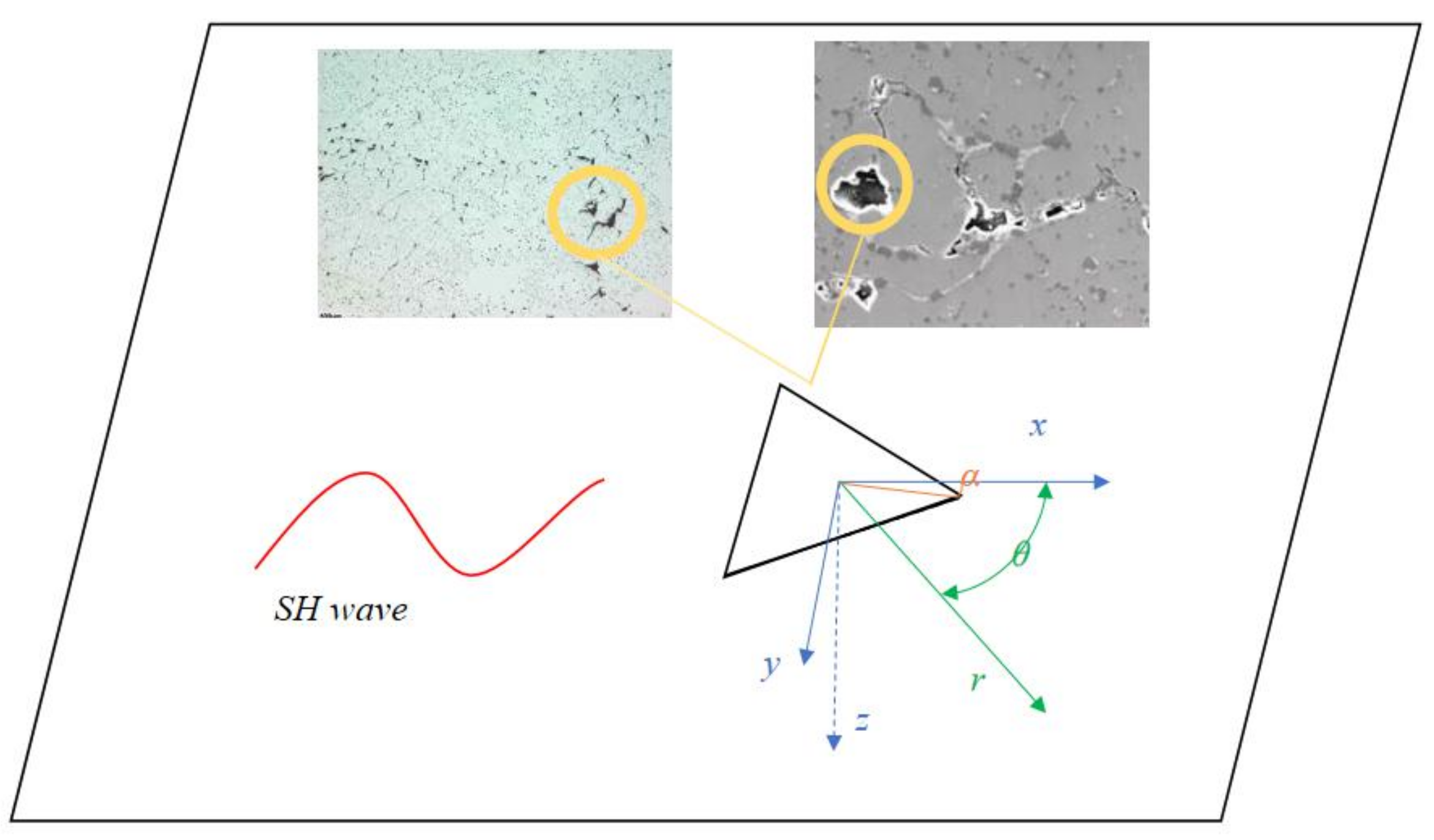
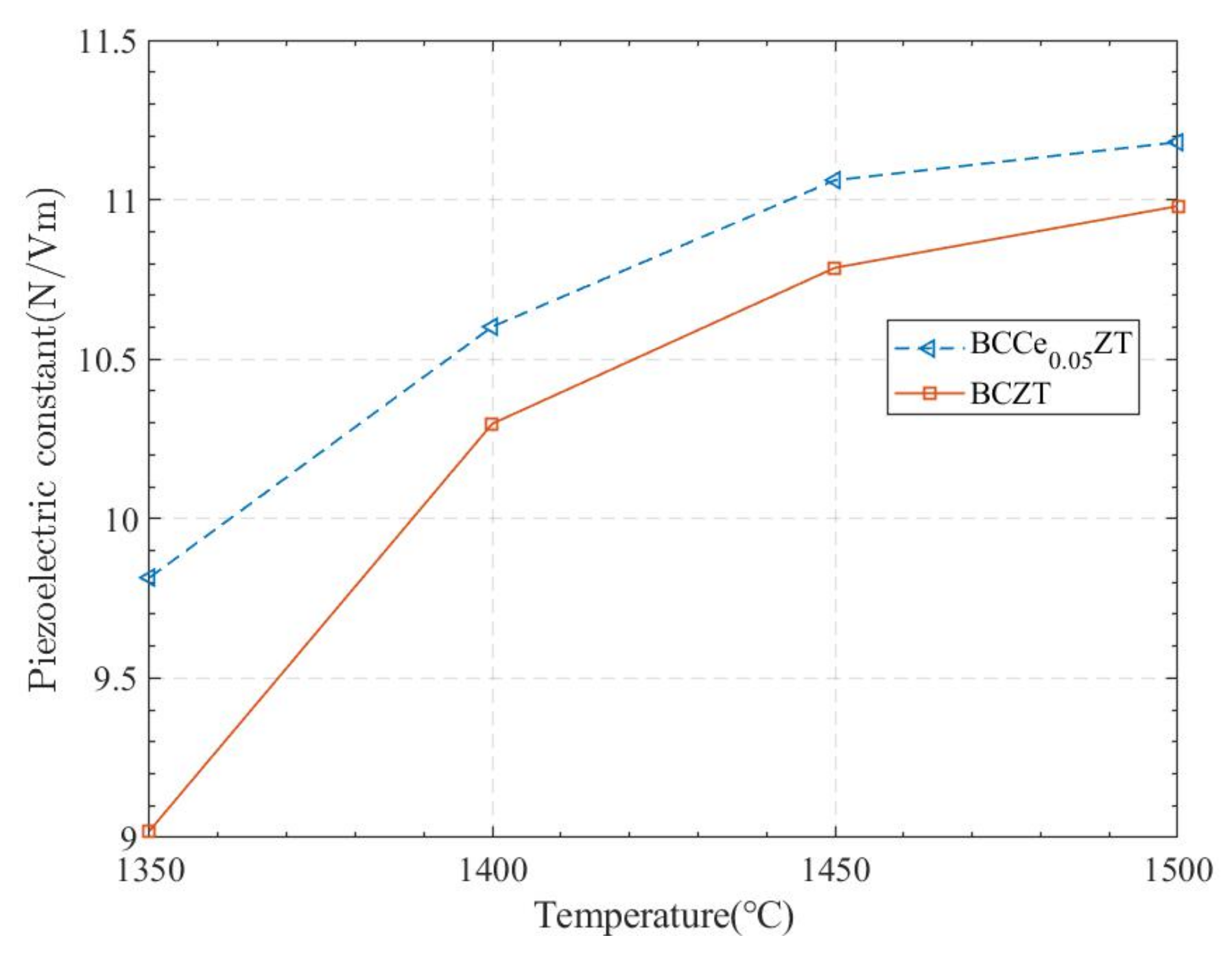

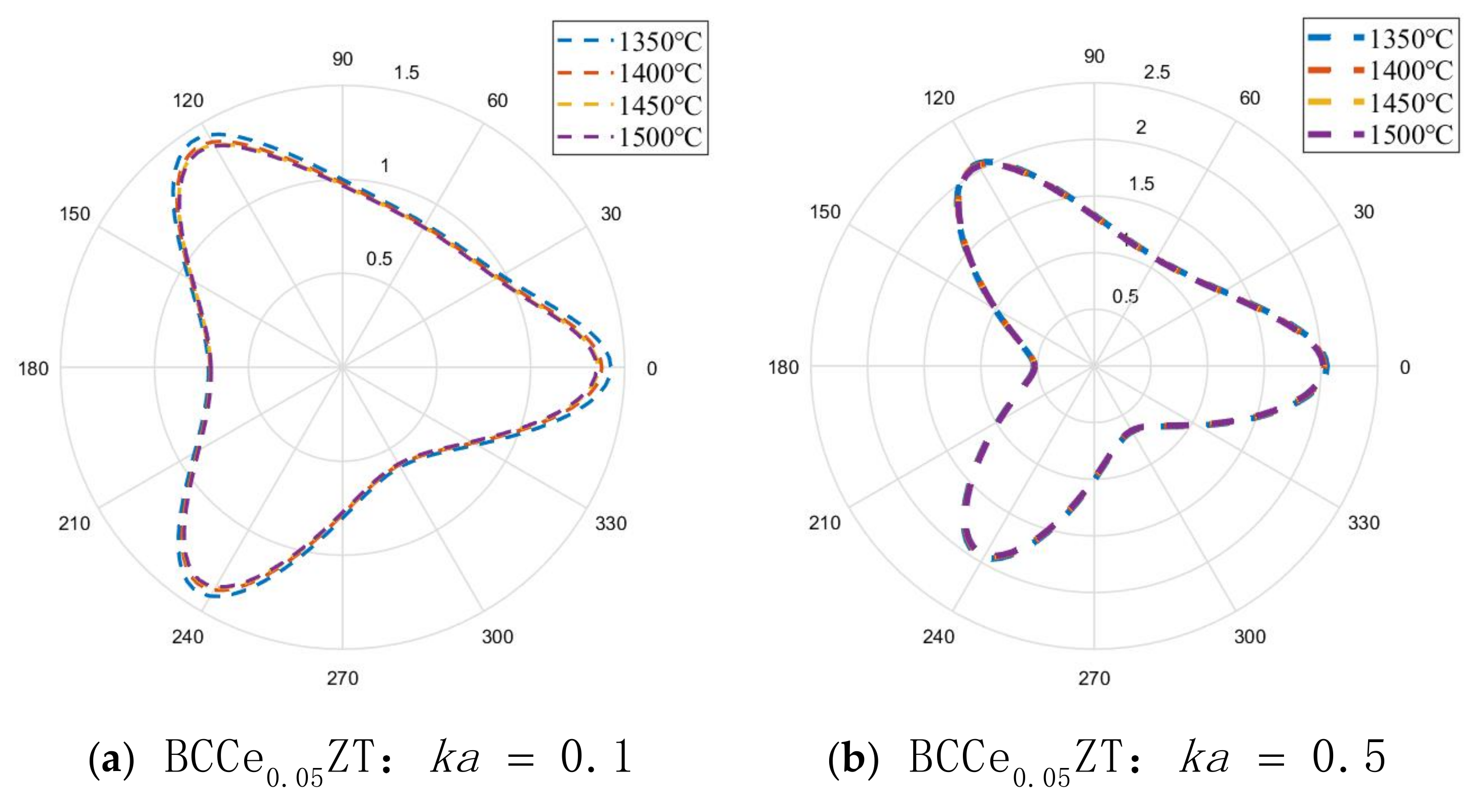
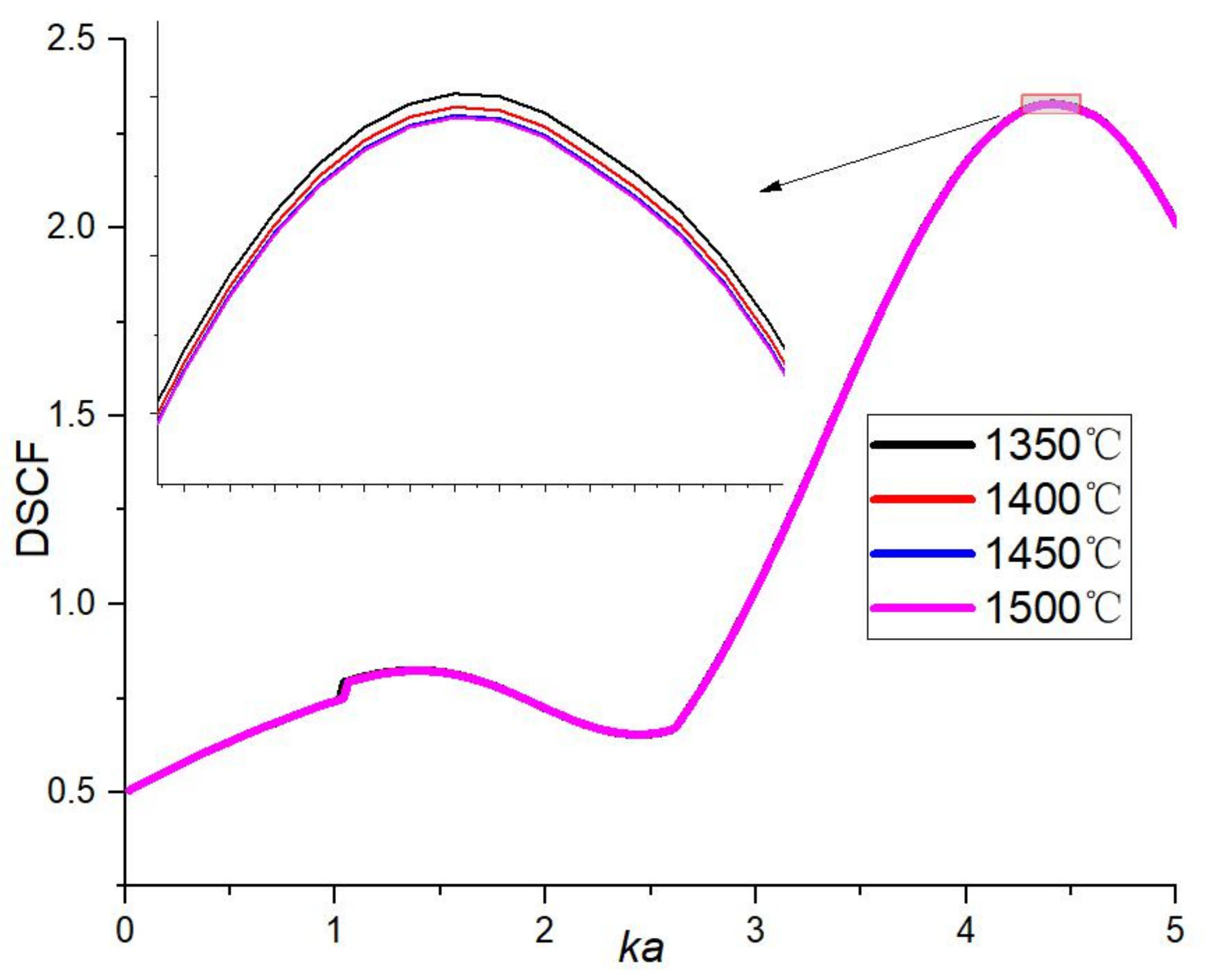

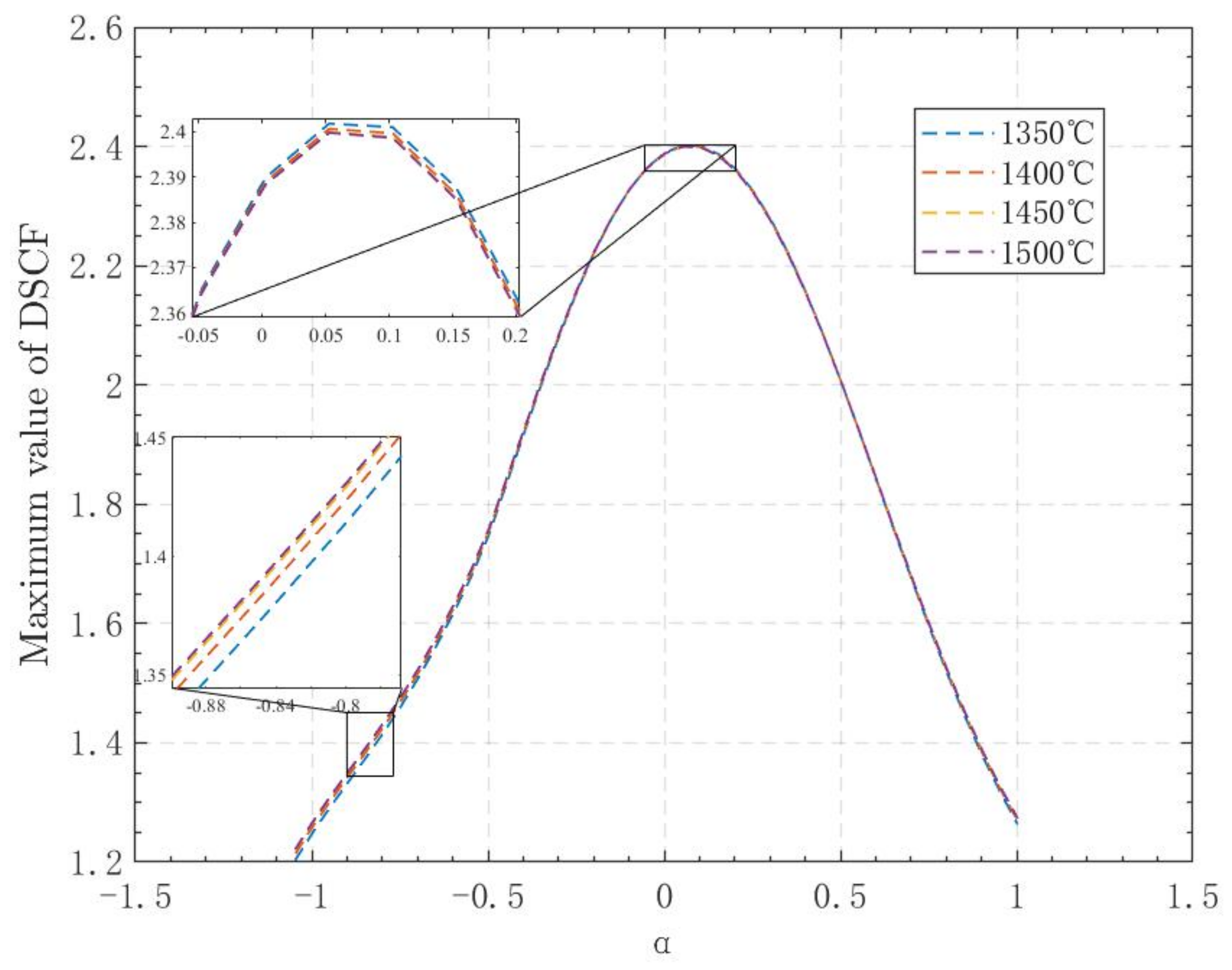
Publisher’s Note: MDPI stays neutral with regard to jurisdictional claims in published maps and institutional affiliations. |
© 2022 by the authors. Licensee MDPI, Basel, Switzerland. This article is an open access article distributed under the terms and conditions of the Creative Commons Attribution (CC BY) license (https://creativecommons.org/licenses/by/4.0/).
Share and Cite
Lin, J.; Ji, H.; Zhou, C.; Fan, J.; Han, X.; Bao, J.; Gong, Y.; Ni, J.; Zhou, W. Electroelastic Coupled-Wave Scattering and Dynamic Stress Concentration of Triangular Defect Piezoceramics. Actuators 2022, 11, 106. https://doi.org/10.3390/act11040106
Lin J, Ji H, Zhou C, Fan J, Han X, Bao J, Gong Y, Ni J, Zhou W. Electroelastic Coupled-Wave Scattering and Dynamic Stress Concentration of Triangular Defect Piezoceramics. Actuators. 2022; 11(4):106. https://doi.org/10.3390/act11040106
Chicago/Turabian StyleLin, Jiang, Huawei Ji, Chuanping Zhou, Jiawei Fan, Xiao Han, Junqi Bao, Yongping Gong, Jing Ni, and Weihua Zhou. 2022. "Electroelastic Coupled-Wave Scattering and Dynamic Stress Concentration of Triangular Defect Piezoceramics" Actuators 11, no. 4: 106. https://doi.org/10.3390/act11040106
APA StyleLin, J., Ji, H., Zhou, C., Fan, J., Han, X., Bao, J., Gong, Y., Ni, J., & Zhou, W. (2022). Electroelastic Coupled-Wave Scattering and Dynamic Stress Concentration of Triangular Defect Piezoceramics. Actuators, 11(4), 106. https://doi.org/10.3390/act11040106





